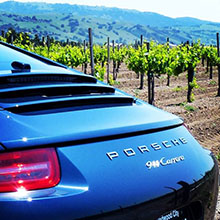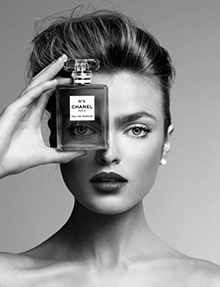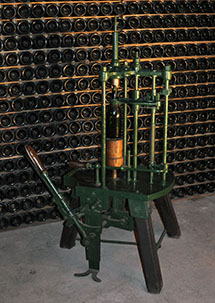|
The Industrial RevolutionRussia became one of the largest importers of champagne after the war ended. Multiple innovations and advancements occurred in the 19th century. Veuve Clicquot hired Antoine Muller in 1810 and the pupitre was developed. The pupitre is a device consisting of 2 rectangular planks with a hinge at the top to form an upside down V with 60 holes on each side cut at 45° angles. The new device accommodated the process of remuage. The process included inserting bottles in a vertical position and rotating them at regular intervals until the bottles were in an upside down position and the dead yeast cells (or lees) were collected in the neck of the bottle. The invention and process were kept secret for use only at the widow’s house until about 1821. In the mid 1830s Andre Francois invented a way to measure the specific amount of residual sugar in wine with the creation of the sucre oenometre. Once the amount sugar was identified, it could be determined how much yeast and additional sugar should be added to generate the secondary bottle fermentation. This precision lessened the chance of bottle explosions. Until the tool and formula were identified there remained a problem that a substantial number of bottle explosions randomly occurred even with the stronger glass. It is estimated that up to 50% of the bottles would often still explode because the amount of pressure caused by adding improper amounts of yeast or sugar could not previously be controlled. It was a dangerous place and cellar workers generally wore iron masks to protect themselves from chance explosions at the time. In 1844 Adolphe Jacquesson developed the wire cage used to keep the cork in place. In 1852 he also developed a machine to wash bottles. In 1857 Louis Pasteur developed the concept that fermentation was biological and caused by microscopic organisms. Pasteur’s experiments led to a much greater understanding of the function of yeast and the overall process of wine and beer making. In 1884 a Belgian, Armand Walfart, developed a new system for disgorgement, “degorgement a la glace”, which incorporates a shallow container filled with a salt solution kept at a very cold temperature. The necks of bottles that had been riddled are placed in the solution. The dead yeast cells or lees that collect in the neck form a mushy plug in the low temperature. The bottle is turned upright and the plug remains in place while the cork is quickly removed. The internal pressure expels the plug, but the lower temperature causes the pressure to decrease enough so most of the clear wine remains in the bottle. Initially and well into the 19th century, all champagne was sweet, very sweet. How was it that this dessert wine would evolve into the widely produced dry “brut” style so popular today? This was another milestone in the 1800s. In its earlier days, champagne would contain anywhere from just over 100 grams per liter (somewhat preferred in the United States at the time) to more than 300 grams per liter (which was the Russians’ preference of the day). “Sec” or “dry” along with “extra sec” or “extra dry” were apparently being produced in the 1850s and 60s. Legend implies that a London wine merchant tasted one of the 1846 vintage champagnes in its unsweetened form and determined it would be a great wine to drink with a meal. Afterward many producers began making champagne with much lower residual sugar levels. Today it is speculative as to the amount of residual sugar associated with the terms “dry” and “extra dry” at that time. They were obviously drier than the basic dessert style that had been the main production. Some may have had no residual sugar at all. In reality, the term “brut” was not associated with champagne until a few years later. Perhaps it is a possibility that “dry” and “extra dry” evolved over time into styles sweeter than brut in today’s terms, but again, that is speculative. Brut translates to raw or crude, which is certainly understood to indicate a dry state. The house of Pommery claims to have produced the first truly “brut” style of champagne, the 1874 “Nature” that was shipped solely to England in 1879. Today’s “brut” contains less than 12 grams per liter of residual sugar. The brut designation was reportedly originally created for the British market. Dosage machines had begun appearing as early as the 1840s. Other innovations that helped industrialize the process for making champagne included the incorporation of corking machines. Continued innovations in the disgorgement process also helped increase production. The industrialization of champagne making led from an annual production of about 600,000 bottles at the beginning of the century to about 30 million by the end of the 1800s. It also made the luxury product, once only obtainable by the aristocrats and nobility, accessible to the middle class. There were many other obstacles that faced the people of Champagne throughout history. One of the biggest problems struck near the end of the century 19th century. The dreaded phylloxera louse found its way to the area around 1890 causing huge losses of vines. Other problems such as low prices and poor living conditions were breeding resentment among growers. The history of champagne continues with World War I - Champagne History Part 5. Related Subjects More about Champagne History
History of the Industrial Revolution |
|||||||||||||||||||||||||||||||||






